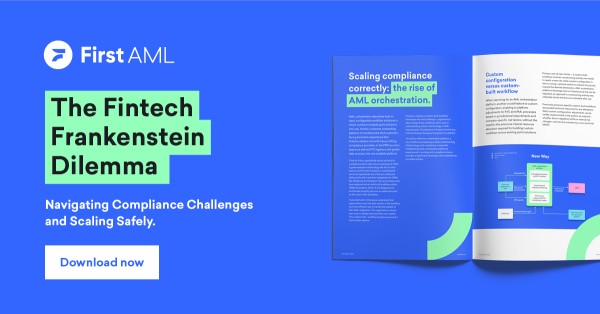The Fintech Frankenstein Dilemma: Navigating Compliance Challenges and Scaling Safely
(Interested in the full whitepaper? Download the PDF here.)
Introduction
“Move fast and break things” is the mantra of the fintech explosion over the last 15 years. But as the industry matures, and governments come to grips with regulating the sector, the mantra is at odds with the changing regulatory landscape.
Fintechs are now expected to “move fast & scale things”. We’re seeing unscalable compliance hindering the scale of these businesses across the globe, with significant de-banking examples, regulatory clamp downs and sharp drops in share price overnight on accusations of money laundering.
This guide will go into some of the common mistakes fintechs make when setting up their compliance functions, the relationship between UI/UX & compliance, and the new wave of regulation technology helping firms do compliance at scale.
We will also look at the optimal new KYC model that fintechs of all sizes (from start-ups to scale-ups) are using to future proof their compliance.
The cost of getting this wrong
The cost of getting compliance wrong for fintechs has never been greater. As U.S. Attorney General Merrick Garland stated, “Using new technology to break the law does not make you a disruptor, it makes you a criminal.”
This comment was made in relation to Binance, which has recently pled guilty to facilitating money laundering and terrorist financing. Due to resulting regulatory pressures, Binance has exited multiple markets, paid $4 billion in U.S. fines, and seen its CEO resign while facing potential jail time and personal fines.
Binance is not the only high profile fintech to be adversely affected by AML issues.
Earlier in 2023, Block and its most profitable product ‘cash-app’ was accused by Hindenburg Research of being the go-to-app for money launderers, gangs and rappers in the US, causing a 35% drop in their share price in one day and wiping billions off their share price.
The impacts aren’t always regulatory. Recently the popular B2B payments and banking provider Wise stopped B2B onboarding due to significant volume increases and issues with letting sanctioned individuals make transfers (of which they are still investigating). They are receiving unprecedented demand but are having to pause customer onboarding, which is the last thing you want to be doing as a fast scaling fintech.
All of the above examples have one thing in common: a scalable front-end user interface, with a focus on new customer onboarding, while lacking the back-end infrastructure to scale their compliance effectively.
The typical KYC Stack
The allure of point solutions
Fintechs are often drawn to front-end focused identity verification and biometric solutions for their slick user interfaces and perception that KYC is a one-time process rather than something requiring ongoing monitoring and infrastructure. The appeal is understandable - who wouldn't want a smooth onboarding flow for customer?
This however, as firms quickly realise, is only one piece of a multi-dimensional puzzle when it comes to their AML obligations. While the front-end customer experience is crucial, many firms overlook the need for robust back-end infrastructure to store data, handle escalations, and enable long-term scaling. Without structured processes on the back-end, processes quickly become un-scalable and prone to breaking. While the front-end dazzles, the back-end infrastructure crumbles.
Challenges encountered by product and operations teams
Typically in an early-stage fintech, the individuals involved in building the onboarding process are product and operations professionals who may lack a deep understanding of AML requirements and workflows.
Building (from scratch) and maintaining such a system can be difficult, especially for early fintechs focusing on customer-facing aspects rather than the less exciting but crucial back-end infrastructure. The lack of attention to these backend elements can contribute to a system that is ineffective at best, non-compliant at worst.
What’s more the integration of multiple point solutions comes with a high cost and complexity. As an early fintech, predicting flow might be difficult, making it difficult to negotiate volume discounts and leading to potential overpayment for services. Vendors may also attempt to lock businesses into onerous contracts, adding further challenges.
This is an excerpt from the whitepaper The Fintech Frankenstein Dilemma: Navigating Compliance Challenges and Scaling Safely. Click here to download the full whitepaper.
About First AML
First AML simplifies the entire anti-money laundering onboarding and compliance process. Its SaaS platform, Source, stands out as a leading solution for organisations with complex or international onboarding needs. It provides streamlined collaboration and ensures uniformity in all AML practices.
First AML transforms an otherwise complex and manual process into one that is simple, cost-effective, and compliant for businesses. By delivering efficiency and time savings, it protects reputations and enables companies to stay on the right side of history in the face of global threats.
Keen to find out more? Book a demo today! No time for a long demo? No problem. See what Source by First AML can do for your business in 2 minutes – watch the short demo here.
